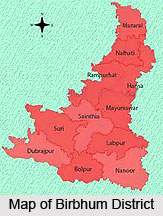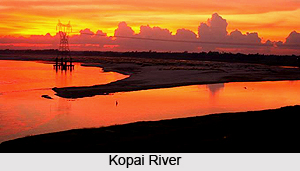 Birbhum district is located in the state of West Bengal in the northernmost part of the Burdwan district. Archaeological survey has revealed that the place has been in existence since pre-historic times. The district has been dominated by different dynasties at different periods of time, and it was even part of the imperial Mauryan Empire at one point in time. The roughly triangular-shaped district is most well known for Shantiniketan, a prime place of tourist interest in all of West Bengal. It is the place where the great Bengali literary figure, Rabindranath Tagore, composed some of his most famous works. Once home to the great man, Shantiniketan is now a university campus housing the Vishwa Bharati University. Tarapith is also a much-visited pilgrimage centre located here.
Birbhum district is located in the state of West Bengal in the northernmost part of the Burdwan district. Archaeological survey has revealed that the place has been in existence since pre-historic times. The district has been dominated by different dynasties at different periods of time, and it was even part of the imperial Mauryan Empire at one point in time. The roughly triangular-shaped district is most well known for Shantiniketan, a prime place of tourist interest in all of West Bengal. It is the place where the great Bengali literary figure, Rabindranath Tagore, composed some of his most famous works. Once home to the great man, Shantiniketan is now a university campus housing the Vishwa Bharati University. Tarapith is also a much-visited pilgrimage centre located here.
History of Birbhum District
When tracing the history of Birbhum district right back to its earliest times, it is seen that Birbhum was initially divided into two tracts, part of it was included in the Rarh district, and the other part in the tract called Vajjrabhumi. The Jains claim that Lord Mahavira, the last great trithankara, had wandered through these tracts as far back as the 5th century AD. The district was under the rule of a number of renowned dynasties. Initially it formed part of the Maurya Empire. Subsequently it went on to be ruled by the imperial Gupta dynasty, the Shahshankas, Harshavardhana, the Pala dynasty and the Sena dynasty. The district came under Muslim rule in the 13th century A.D. They left the reigns of administration to the Hindu chiefs, Bir Rajas. Following this, Birbhum came under British rule and was administered by them. It was re-constituted into a separate district in 1820.
Geography of Birbhum District
The district is well drained by a number of rivers and rivulets running in nearly every case from west to east with a slight southerly inclination. Only two are rivers of any magnitude, viz., the Mor and the Ajay, the latter of which marks the southern boundary, while the Mor runs through Birbhum from West to East. Both rivers are of considerable size when they enter the district, their width varying according to the configuration of the country, from two hundred yards to half a mile.
 The climate of the district is generally dry, mild and healthy. Summer lasts from the middle of March to the middle of June, monsoon from the middle of June to the middle of October and winter lasts from the middle of October to the middle of March. As a rule, the wind is from south-east in summer and from the north-west in winter. The eastern portion of the district is a continuation of the rice plain of West Bengal, and the vegetation is characteristic of rice fields in Bengal. Apart from this, trees like mango tree, palm, and bamboo are frequently found. Other abundant species are jack, arjun, sal, piar, dhau, kend and mahua. The carnivores of the district include the leopards, bear, wolf and other small species. Birbhum district lies in the northernmost division of the Bardhaman division in the state of West Bengal. It is located between 23 degrees 32 minutes and 24 degrees 35 minutes north latitude and 88 degrees 1 minute east and 87 degrees 5 minutes east longitude. The district is roughly triangular in shape. The tip of this is situated at the northern extremity not far south of the point where the Ganges and the hills of the Santhal Parganas begin to diverge. The base of this triangle is formed by the river Ajay. Extending over a total area of 4545 Sq. Kms, Birbhum district is bounded by the Santhal Parganas on the north and West, by the Murshidabad district and Bardhaman district on the east and on the south by Bardhaman. It is separated from the last by the Ajay River.
The climate of the district is generally dry, mild and healthy. Summer lasts from the middle of March to the middle of June, monsoon from the middle of June to the middle of October and winter lasts from the middle of October to the middle of March. As a rule, the wind is from south-east in summer and from the north-west in winter. The eastern portion of the district is a continuation of the rice plain of West Bengal, and the vegetation is characteristic of rice fields in Bengal. Apart from this, trees like mango tree, palm, and bamboo are frequently found. Other abundant species are jack, arjun, sal, piar, dhau, kend and mahua. The carnivores of the district include the leopards, bear, wolf and other small species. Birbhum district lies in the northernmost division of the Bardhaman division in the state of West Bengal. It is located between 23 degrees 32 minutes and 24 degrees 35 minutes north latitude and 88 degrees 1 minute east and 87 degrees 5 minutes east longitude. The district is roughly triangular in shape. The tip of this is situated at the northern extremity not far south of the point where the Ganges and the hills of the Santhal Parganas begin to diverge. The base of this triangle is formed by the river Ajay. Extending over a total area of 4545 Sq. Kms, Birbhum district is bounded by the Santhal Parganas on the north and West, by the Murshidabad district and Bardhaman district on the east and on the south by Bardhaman. It is separated from the last by the Ajay River.
Economy of Birbhum District
Birbhum is an important district in the Rarh region having a considerable area under undulating topography in the western part of the district. It is primarily an agriculture-based district. The district has made a gradual progress in the field of agriculture through the gradual development of irrigation facilities, introduction of high yielding varieties and adoption of improved technology by the cultivators. Rice is the major crop of this district and occupies about 70 percent of the grossed cropped area. The other important crops are wheat, potato, mustard, vegetables, sugarcane and pulses. Now the district has attained surplus production in case of paddy, potato and vegetables. The agriculture extension wing of the state Government has played the key role in achieving this success. There are two major irrigation sources in this district - Mayurkhshi Reservoir Project is the biggest and Hinglow River Project is the other. Utilizing the existing prospects of horticultural crops in the district, the Food Processing Industries and Horticulture Department, Government of West Bengal has opened up the avenues among the growers for expansion of horticulture e.g., vegetables, fruits, flowers, spices, medicinal and aromatic plants etc. which in turn would increase the nutritional status as well as standard of living.
 Birbhum District is advantageously located beside the rich industrial region of Durgapur and Asansol. The district is well connected with good roads. The Panagarh - Moregram Road of 150 Km connecting two National High ways has proved a lifeline for the economy of this district. This district, taken together with the region of Durgapur-Asansol, has plenty of human resources. Adequate land is available for setting up industries and other projects. The district has abundant reserve of mineral resources like china clay, stone, coal, quartz and feldspar and geothermal resources. There is plenty of scope to set up mineral based industries. The S.S.D.A. with its perspective plan 2025 and Project of Mega Growth Centre will certainly create enough scope and accelerate growth of industrialisation and all round development in the district.
Birbhum District is advantageously located beside the rich industrial region of Durgapur and Asansol. The district is well connected with good roads. The Panagarh - Moregram Road of 150 Km connecting two National High ways has proved a lifeline for the economy of this district. This district, taken together with the region of Durgapur-Asansol, has plenty of human resources. Adequate land is available for setting up industries and other projects. The district has abundant reserve of mineral resources like china clay, stone, coal, quartz and feldspar and geothermal resources. There is plenty of scope to set up mineral based industries. The S.S.D.A. with its perspective plan 2025 and Project of Mega Growth Centre will certainly create enough scope and accelerate growth of industrialisation and all round development in the district.
Tourism in Birbhum District
There are a number of places of tourist interest located in the Birbhum district. By far the most famous tourist spot here, and in fact a top draw in all of West Bengal, is Shantiniketan. It is the place where Rabindranath Tagore lived and composed some of his most famous literary pieces. It is now a University town, and the famous Visva- Bharati University is also found located here. A number of seasonal festivals are celebrated here with great pomp and vigour. Apart from this, places of pilgrimage, called piths are also found in the district. The piths are said to be the places where one of the many dismembered parts of Sati fell. These piths in the Birbhum district are located at Tarapith, Bakreshwar, Kaklitala, Labpur etc.






